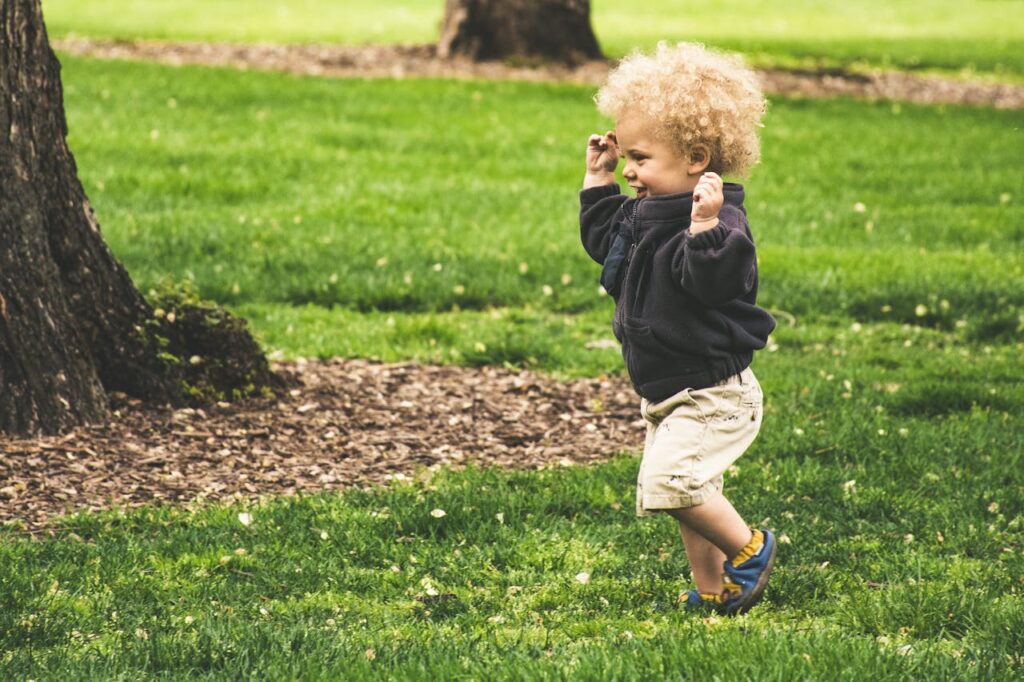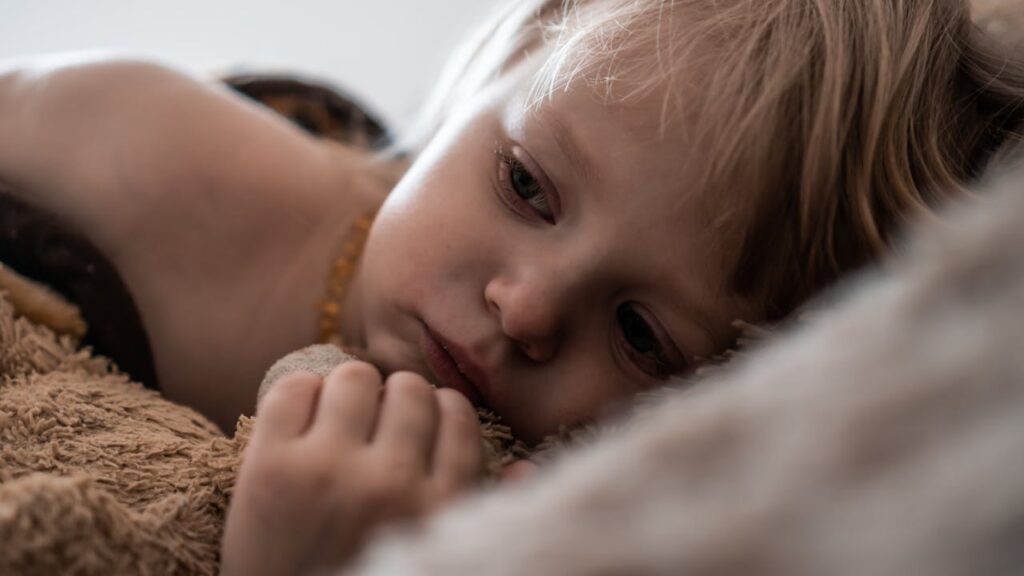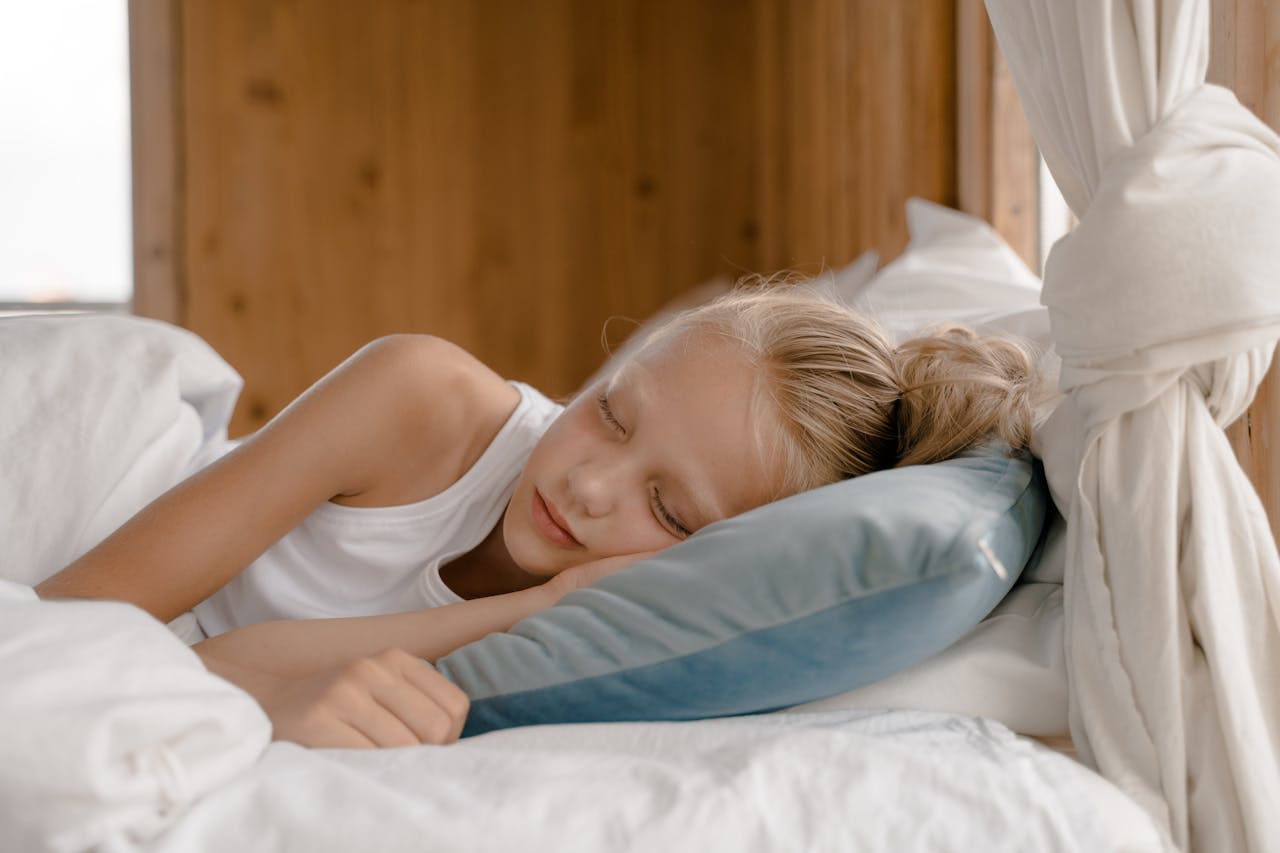As parents, we can all relate to the challenge of getting our kids to bed on time—and ensuring they stay there! It’s concerning to note that children who lack sufficient sleep may face behavioural issues, trouble focusing, and even weight concerns. But fear not, we’re here to help. In this detailed guide, we’ll cover all the essential sleep habits for kids, including how to set up effective bedtime routines and address those annoying sleep disruptions. So, pour yourself a cup of coffee (you’ll definitely need it!), and let’s explore the realm of restful nights and sweet dreams!
Understanding Sleep Needs Across Different Age Groups
When it comes to sleep, one size definitely doesn’t fit all, especially for our little ones. As children grow and develop, their sleep needs change dramatically. Let’s break it down by age group to help you understand what to expect and how to support your child’s sleep at every stage.
Newborns (0-3 months): Sleep Patterns and Duration

Newborns are notoriously unpredictable sleepers. In the first few months of life, babies sleep a lot – typically 14 to 17 hours a day – but in short bursts[1]. This erratic sleep pattern is due to their tiny tummies needing frequent feedings and their immature circadian rhythms.
At this stage, newborns haven’t yet developed a day-night cycle, which means they might be wide awake at 2 am and sound asleep at noon. It’s important for parents to understand that this is completely normal. Your job isn’t to force a schedule but to respond to your baby’s needs and gradually help them distinguish between day and night.
To support your newborn’s sleep:
- Keep nighttime interactions calm and quiet
- Use dim lights during night feedings
- Gradually introduce more stimulation during daytime hours
Every baby is unique. Some might sleep for longer periods sooner than others, and that’s perfectly normal.
Infants (4-11 months): Establishing Sleep Routines

As babies move into the infant stage, their sleep patterns begin to consolidate. By 6 months, many babies can sleep for longer stretches at night and take 2 to 3 naps during the day. This is an excellent time to start establishing sleep routines.
A consistent bedtime routine helps signal to your baby that it’s time to wind down. This might include:
- A warm bath
- Changing into pyjamas
- Reading a story
- Singing a lullaby
- Cuddling
The secret lies in being consistent. Aim to perform these activities in the same sequence every night. Gradually, your baby will begin to link these routines with sleep, which will help make bedtime smoother.
During this stage, some parents choose to start sleep training. There are various methods, from “cry it out” to more gradual approaches. Whatever you choose, it’s essential to be consistent and patient. Remember, what works for one family might not work for another, so don’t be afraid to adjust your approach if needed.
Toddlers (1-2 years): Transitioning to Fewer Naps

The toddler years bring new sleep challenges. Most toddlers need about 11-14 hours of sleep in a 24-hour period, including naps[2]. Around 18 months, many children transition from two naps to one, which can be a tricky period for both toddlers and parents.
Signs your toddler might be ready to drop a nap include:
- Resisting the morning or afternoon nap
- Taking a long time to fall asleep at naptime
- Sleeping well for one nap but not the other
- Nighttime sleep being affected (taking longer to fall asleep or waking early)
When transitioning to one nap, try to push the remaining nap to around midday. This helps balance your toddler’s sleep needs throughout the day.
Toddlers are also notorious for bedtime resistance. They’re learning independence and may test boundaries around sleep. Stick to your routine and be patient. Offering limited choices can help toddlers feel more in control. For example, “Do you want to wear the blue pyjamas or the red ones?”
Preschoolers (3-5 years): Dealing with Bedtime Resistance

Preschoolers typically need 10-13 hours of sleep per day, including any naps[2]. By age 5, most children have dropped naps altogether, making a good night’s sleep even more crucial.
Bedtime resistance often peaks during the preschool years. Common reasons include:
- Fear of missing out on family activities
- Separation anxiety
- Newfound independence
- Vivid imaginations lead to fear of the dark or monsters
To manage bedtime resistance:
- Maintain a consistent bedtime routine
- Address fears calmly and provide comfort objects if needed
- Use a reward system for good bedtime behaviour
- Ensure the sleep environment is comfortable and secure
- Limit stimulating activities before bed
It’s also common for preschoolers to experience sleep disruptions due to developmental milestones or changes in their environment. Be patient and consistent, and most sleep issues will be resolved with time.
School-age children (6-13 years): Balancing Sleep with Increased Responsibilities

As children enter school age, their sleep needs gradually decrease, but good sleep remains crucial for learning, emotional regulation, and overall health. School-age children typically need 9-11 hours of sleep per night[2].
However, this is also when external factors start to impact sleep more significantly:
- Homework and after-school activities can push bedtimes later
- Early school start times may lead to insufficient sleep
- Increased screen time can interfere with natural sleep cycles
- Social pressures and academic stress may cause sleep anxiety
To support healthy sleep in school-age children:
- Maintain a consistent sleep schedule, even on weekends
- Create a calm, screen-free bedtime routine
- Ensure the bedroom is dark, quiet, and cool
- Help your child manage their schedule to allow for adequate sleep
- Model good sleep habits yourself
Quality sleep is just as crucial as the amount of sleep your child gets. If you notice your child feeling tired throughout the day or struggling in school, it could be helpful to talk to a paediatrician about their sleep patterns.
The Importance of Consistent Bedtime Routines

Establishing a consistent bedtime routine is one of the most effective ways to promote healthy sleep habits for kids. A good routine helps signal to the body and mind that it’s time to wind down, making the transition to sleep smoother and more natural.
Benefits of a Regular Sleep Schedule
Consistency is key when it comes to sleep. A regular sleep schedule helps regulate the body’s internal clock or circadian rhythm. This internal clock influences many bodily functions, including hormone production, body temperature, and, of course, the sleep-wake cycle.
When children go to bed and wake up at roughly the same time each day, their bodies learn to expect sleep at certain times. This can lead to:
- Easier bedtimes with less resistance
- Quicker sleep onset
- Fewer night wakings
- More restful sleep overall
- Better mood and behaviour during the day
- Improved cognitive function and academic performance
Even on weekends or during vacations, try to keep bedtimes and wake times within an hour of the usual schedule. This helps maintain the rhythm and makes the transition back to the regular routine easier.
Components of an Effective Bedtime Routine
An effective bedtime routine doesn’t need to be complicated, but it should be consistent. Here are some key components to consider:
- Set a consistent bedtime: Choose a bedtime that allows for adequate sleep before your child needs to wake up.
- Give a heads-up: Start signalling that bedtime is approaching about 30 minutes before you actually begin the routine.
- Calm, quiet activities: Engage in relaxing activities that help your child wind down.
- Personal care: Include tasks like brushing teeth, using the bathroom, and changing into pyjamas.
- Comfort and connection: End with a quiet moment of connection, like reading a story or having a brief chat about the day.
- Goodnight ritual: Finish with a consistent goodnight phrase or action.
The entire routine should last about 30-60 minutes, depending on your child’s age and needs.
Age-appropriate Bedtime Activities
The specific activities in a bedtime routine may vary based on your child’s age and preferences. Here are some ideas:
For infants and toddlers:
- Warm bath
- Gentle massage
- Singing lullabies
- Reading a short book
- Rocking or cuddling
For preschoolers and early school-age children:
- Bath or shower
- Picking out pajamas
- Reading stories
- Quiet talk about the day
- Listening to calm music
For older children:
- Shower or bath
- Light stretching or yoga
- Reading
- Journaling
- Mindfulness exercises or meditation
It’s important to select soothing activities that your child loves and that promote relaxation.
Creating a Sleep-friendly Environment
The sleep environment plays a crucial role in promoting good sleep. Here are some tips for creating a sleep-friendly bedroom:
- Darkness: Use blackout curtains or shades to block out light. This is especially important in the summer when days are longer.
- Cool temperature: Keep the room between 60-67°F (15-19°C) for optimal sleep[3].
- Quiet: If outside noise is an issue, consider using a white noise machine or fan to create consistent background noise.
- Comfortable bedding: Ensure your child has a supportive mattress and comfortable, breathable bedding.
- Clutter-free space: A tidy room can promote a sense of calm and reduce distractions.
- Familiar comfort objects: Allow young children to have a favourite stuffed animal or blanket for comfort.
Limiting Screen Time Before Bed
In our digital age, managing screen time is a crucial part of promoting good sleep. The blue light emitted by screens can interfere with the production of melatonin, the hormone that regulates sleep[4].
To mitigate the impact of screens on sleep:
- Establish a “screen curfew” at least an hour before bedtime
- Keep TVs, computers, and mobile devices out of the bedroom
- Use blue light filters on devices in the evening if they must be used
- Model good habits by limiting your own screen use before bed
Establishing a soothing bedtime routine and a sleep-conducive atmosphere helps your child cultivate lasting healthy sleep habits that can benefit them throughout their life.
Common Sleep Issues in Children and How to Address Them

Even with the best routines and environments in place, many children experience sleep issues at some point. Understanding these common problems and how to address them can help both you and your child get the rest you need.
Night Terrors and Nightmares: Causes and Coping Strategies
Both night terrors and nightmares are sleep disturbances, but they’re quite different in nature and how they should be handled.
Night Terrors
Night terrors typically occur in the first few hours of sleep during non-REM sleep. They’re more common in children aged 3-12 years[5]. During a night terror, a child may:
- Suddenly sit up in bed
- Scream or shout
- Have a rapid heart rate
- Appear frightened but be unresponsive to comfort
Causes of night terrors can include:
- Sleep deprivation
- Stress or anxiety
- Fever or illness
- Certain medications
How to cope with night terrors:
- Don’t try to wake the child; they’ll likely be disoriented and confused
- Ensure the environment is safe to prevent injury
- Speak calmly and reassuringly
- Track when they occur and wake the child about 15 minutes before that time to potentially disrupt the cycle
Nightmares
Nightmares, on the other hand, occur during REM sleep, usually in the latter part of the night. They’re more common in children aged 3-6 years[6]. Unlike with night terrors, children usually remember nightmares and may be afraid to go back to sleep.
Causes of nightmares can include:
- Stress or anxiety
- Traumatic experiences
- Certain medications
- Watching scary or intense content before bed
How to cope with nightmares:
- Comfort and reassure your child
- Encourage them to talk about the dream if they want to
- Provide a comfort object like a stuffed animal
- Use a nightlight if darkness is a fear
- Teach relaxation techniques to use before sleep
Sleepwalking and Sleep Talking: Safety Measures and Management
Both sleepwalking and sleep talking are parasomnia behaviours that occur during non-REM sleep, typically in the first third of the night.
Sleepwalking
Sleepwalking is more common in children than adults, with a peak occurrence between ages 8-12[7]. While sleepwalking itself isn’t dangerous, the potential for injury during an episode is a concern.
Safety measures for sleepwalking:
- Ensure doors and windows are locked
- Remove tripping hazards from the bedroom and hallways
- Consider a bell on the bedroom door to alert you
- Use gates at the top of the stairs
Management strategies:
- Maintain a consistent sleep schedule
- Reduce stress and anxiety
- Avoid caffeine and heavy meals close to bedtime
- Wake the child about 15-30 minutes before they typically sleepwalk
Sleep Talking
Sleep talking is generally harmless and doesn’t require treatment. However, if it’s frequent or distressing, consider:
- Reducing stress
- Improving sleep hygiene
- Addressing any underlying sleep disorders
Bedwetting: Understanding Causes and Treatment Options
Bedwetting, or nocturnal enuresis, is common in young children. Most children outgrow it by age 5, but it can persist in some children[8].
Causes of bedwetting can include:
- Delayed development of bladder control
- Genetics
- Deep sleep
- Stress or anxiety
- Constipation
- Urinary tract infection
Treatment options:
- Patience and reassurance (most children outgrow it naturally)
- Limiting fluids before bed
- Scheduled bathroom trips before sleep
- Bedwetting alarms
- In some cases, medication (consult with a paediatrician)
Sleep Apnea in Children: Symptoms and When to Seek Medical Help
Sleep apnea, a condition where breathing repeatedly stops and starts during sleep, can occur in children. While it’s less common than in adults, it can have significant impacts on a child’s health and development.
Symptoms of sleep apnea in children include:
- Loud snoring
- Pauses in breathing during sleep
- Restless sleep
- Mouth breathing
- Daytime sleepiness
- Behavioural issues or poor school performance
If you suspect your child may have sleep apnea, it’s important to consult a paediatrician. They may recommend:
- A sleep study
- Removal of tonsils and adenoids if they’re enlarged
- Use of a CPAP machine in some cases
Insomnia in Kids: Identifying Triggers and Promoting Relaxation
While less common than in adults, children can experience insomnia too. This can manifest as difficulty falling asleep, staying asleep, or both.
Common triggers for insomnia in children include:
- Anxiety or stress
- Changes in routine or environment
- Caffeine consumption
- Medical conditions or medications
- Poor sleep habits
To promote relaxation and combat insomnia:
- Maintain a consistent bedtime routine
- Create a calm, comfortable sleep environment
- Teach relaxation techniques like deep breathing or progressive muscle relaxation
- Limit screen time before bed
- Address any underlying anxiety or stress
- Consider cognitive-behavioral therapy for persistent insomnia
It’s important to keep in mind that although these strategies can assist with various sleep challenges, ongoing issues should be addressed with a paediatrician. They can help identify any underlying health concerns and offer personalized guidance for your child’s unique needs.
The Role of Diet and Exercise in Children’s Sleep
What your child eats and how much they move during the day can have a significant impact on their sleep at night. Understanding this connection can help you make choices that promote better sleep for your little one.
Foods that Promote Better Sleep

Certain foods contain nutrients that can help promote sleep. While it’s not about forcing your child to eat specific “sleep foods,” incorporating these into their regular diet may help:
Tryptophan-rich foods: This amino acid is a precursor to melatonin, the sleep hormone. Foods high in tryptophan include:
- Turkey
- Chicken
- Eggs
- Cheese
- Nuts and seeds
- Bananas
Complex carbohydrates: These can help make tryptophan more available to the brain. Good sources include:
- Whole grain bread
- Oatmeal
- Sweet potatoes
- Brown rice
Calcium-rich foods: Calcium helps the brain use tryptophan to produce melatonin. Good sources include:
- Milk
- Yoghurt
- Cheese
- Leafy greens
Magnesium-rich foods: Magnesium is a natural relaxant. Good sources include:
- Nuts and seeds
- Bananas
- Avocados
- Dark chocolate (in moderation)
Timing of Meals and Snacks
When your child eats can be just as important as what they eat when it comes to sleep. Here are some timing considerations:
Avoid large meals close to bedtime: Eating a big meal right before bed can lead to discomfort and indigestion, making it harder to fall asleep.
If a bedtime snack is needed, keep it light: A small snack combining complex carbs and protein can be helpful. For example:
- A small bowl of whole-grain cereal with milk
- A piece of whole-grain toast with peanut butter
- A banana with a few nuts
Be mindful of dinner timing: Try to have dinner at least 2-3 hours before bedtime to allow for proper digestion.
The Impact of Sugar on Sleep Quality
Sugar can interfere with sleep, especially when consumed later in the day.
- Can cause a quick energy boost followed by a crash
- May lead to middle-of-the-night wakings as blood sugar levels fluctuate
- Should be limited, especially in the hours leading up to bedtime
Importance of Regular Physical Activity for Sleep

Regular exercise can significantly improve sleep quality. Here’s how:
- Helps regulate the sleep-wake cycle: Exposure to natural light during outdoor activities helps reinforce the body’s natural circadian rhythm.
- Reduces stress and anxiety: Physical activity releases endorphins, which can help reduce stress and promote relaxation.
- Tires the body: Regular exercise can help children fall asleep faster and enjoy deeper sleep.
- Improves overall health: Regular physical activity contributes to better overall health, which in turn promotes better sleep.
For the best sleep benefits, encourage your child to be active during the day, but try to avoid vigorous exercise close to bedtime as it can be stimulating.
Balancing After-School Activities with Adequate Rest
While after-school activities are important for development and socialization, it’s crucial to balance these with your child’s need for rest. Here are some tips:
- Prioritize activities: Help your child choose activities they truly enjoy rather than overloading their schedule.
- Schedule downtime: Ensure there’s time between school, activities, and bedtime for relaxation and winding down.
- Be mindful of timing: If possible, schedule more intense activities earlier in the day rather than close to bedtime.
- Watch for signs of overtiredness: If your child is consistently cranky, having trouble concentrating, or resisting bedtime, they might be overscheduled.
- Maintain a consistent bedtime: Even on busy days, try to stick to the regular bedtime routine as much as possible.
Every child is unique, so it’s important to observe how your little one reacts to various foods, levels of activity, and daily routines. If you spot any trends that seem to impact their sleep, you can make changes to support their need for adequate rest, which is essential for their healthy growth and development.
Technology and Sleep: Finding the Right Balance

In today’s digital age, managing technology use is a crucial aspect of promoting healthy sleep habits for kids. While technology can offer many benefits, it can also significantly impact sleep quality if not properly managed.
Effects of Screen Time on Sleep Quality
Screen time, especially close to bedtime, can interfere with sleep in several ways:
- Blue light exposure: The blue light emitted by screens can suppress melatonin production, making it harder to fall asleep[9].
- Mental stimulation: Engaging content can keep the mind active when it should be winding down.
- Delayed bedtimes: The “just one more” phenomenon can push bedtimes later and later.
- Sleep disruption: Notifications or the temptation to check devices can interrupt sleep during the night.
- Reduced sleep duration: Excessive screen time can lead to later bedtimes without a corresponding shift in wake times, resulting in less overall sleep.
Setting Boundaries for Device Usage
To mitigate the negative impacts of technology on sleep, it’s important to set clear boundaries:
- Establish a “digital curfew”: Set a time (ideally 1-2 hours before bed) when all devices are turned off or put away.
- Create device-free zones: Keep bedrooms screen-free to associate them with rest rather than activity.
- Use parental controls: Set time limits on devices or use apps that automatically reduce blue light in the evening.
- Model good behaviour: Children often mimic their parent’s behaviour, so be mindful of your own device use.
- Gradual wind-down: If completely eliminating evening screen time isn’t feasible, gradually reduce screen brightness and switch to calmer activities as bedtime approaches.
Alternatives to Screen-Based Activities Before Bed
Encouraging non-screen activities before bed can help children wind down naturally. Some ideas include:
- Reading books
- Listening to audiobooks or calm music
- Drawing or colouring
- Doing puzzles
- Practicing yoga or gentle stretching
- Having quiet conversations as a family
- Playing board games or card games
- Engaging in mindfulness activities or meditation
Using Technology to Track and Improve Sleep Habits for Kids
While excessive technology use can hinder sleep, some tech tools can actually help improve sleep habits for kids:
- Sleep tracking apps: These can help older children and teens understand their sleep patterns.
- Smart alarm clocks: These can wake children at the optimal point in their sleep cycle.
- White noise apps: These can provide soothing background noise to help with falling asleep.
- Meditation apps: Guided meditations can help children relax before bed.
- Blue light filtering apps: These adjust screen colour temperature in the evening to reduce blue light exposure.
Age-appropriate Apps and Tools for Better Sleep
When choosing sleep-related apps or tools for children, consider their age and developmental stage:
For younger children (ages 3-8):
- Bedtime story apps with calming narratives
- Simple meditation apps with kid-friendly guided visualizations
- Night light apps that gradually dim over time
For older children and teens (ages 9+):
- Sleep cycle alarm apps
- More advanced meditation and mindfulness apps
- Sleep tracking apps (with parental guidance)
It’s important to keep in mind that while these tools can be beneficial, they are meant to enhance, not substitute, healthy sleep habits for kids.
When introducing any sleep-related technology, it’s important to:
- Review the app or tool yourself first
- Use it together with your child initially
- Monitor its impact on your child’s sleep and overall well-being
- Be prepared to adjust or discontinue use if it’s not helpful
By setting clear boundaries around technology use and leveraging helpful tools when appropriate, you can help your child develop a healthy relationship with technology that supports, rather than hinders, good sleep.
Conclusion
We’ve explored a lot about children’s sleep! From recognizing their evolving sleep requirements to addressing typical sleep challenges, you now have the tools to ensure your little ones get the rest they deserve. Keep in mind that each child is different, so feel free to try out various approaches to see what suits your family best. Creating healthy sleep routines from an early age can pave the way for a lifetime of restful nights – and believe me, both you and your kids will appreciate it! So, what’s the first adjustment you plan to make to enhance your child’s sleep tonight?
Reference
[1] Hirshkowitz, M., Whiton, K., Albert, S. M., Alessi, C., Bruni, O., DonCarlos, L., Hazen, N., Herman, J., Katz, E. S., Kheirandish-Gozal, L., Neubauer, D. N., O’Donnell, A. E., Ohayon, M., Peever, J., Rawding, R., Sachdeva, R. C., Setters, B., Vitiello, M. V., Ware, J. C., & Adams Hillard, P. J. (2015). National Sleep Foundation’s sleep time duration recommendations: methodology and results summary. Sleep health, 1(1), 40–43. https://doi.org/10.1016/j.sleh.2014.12.010
[2] Paruthi, S., Brooks, L. J., D’Ambrosio, C., Hall, W. A., Kotagal, S., Lloyd, R. M., Malow, B. A., Maski, K., Nichols, C., Quan, S. F., Rosen, C. L., Troester, M. M., & Wise, M. S. (2016). Recommended Amount of Sleep for Pediatric Populations: A Consensus Statement of the American Academy of Sleep Medicine. Journal of clinical sleep medicine : JCSM : official publication of the American Academy of Sleep Medicine, 12(6), 785–786. https://doi.org/10.5664/jcsm.5866
[3] Sleep Foundation. (2024). The Best Temperature for Sleep. https://www.sleepfoundation.org/bedroom-environment/best-temperature-for-sleep
[4] Gringras, P., Middleton, B., Skene, D. J., & Revell, V. L. (2015). Bigger, Brighter, Bluer-Better? Current Light-Emitting Devices – Adverse Sleep Properties and Preventative Strategies. Frontiers in public health, 3, 233. https://doi.org/10.3389/fpubh.2015.00233
[5] Mason, T. B. A. II, & Pack, A. I. (2007). Pediatric parasomnias. Sleep: Journal of Sleep and Sleep Disorders Research, 30(2), 141–151. https://doi.org/10.1093/sleep/30.2.141
[6] Mindell, J. A., & Barrett, K. M. (2002). Nightmares and anxiety in elementary-aged children: is there a relationship. Child: care, health and development, 28(4), 317–322. https://doi.org/10.1046/j.1365-2214.2002.00274.x
[7] Petit, D., Pennestri, M. H., Paquet, J., Desautels, A., Zadra, A., Vitaro, F., Tremblay, R. E., Boivin, M., & Montplaisir, J. (2015). Childhood Sleepwalking and Sleep Terrors: A Longitudinal Study of Prevalence and Familial Aggregation. JAMA pediatrics, 169(7), 653–658. https://doi.org/10.1001/jamapediatrics.2015.127
[8] Nevéus T. (2017). Pathogenesis of enuresis: Towards a new understanding. International journal of urology : official journal of the Japanese Urological Association, 24(3), 174–182. https://doi.org/10.1111/iju.13310
[9] Chang, A. M., Aeschbach, D., Duffy, J. F., & Czeisler, C. A. (2015). Evening use of light-emitting eReaders negatively affects sleep, circadian timing, and next-morning alertness. Proceedings of the National Academy of Sciences of the United States of America, 112(4), 1232–1237. https://doi.org/10.1073/pnas.1418490112


